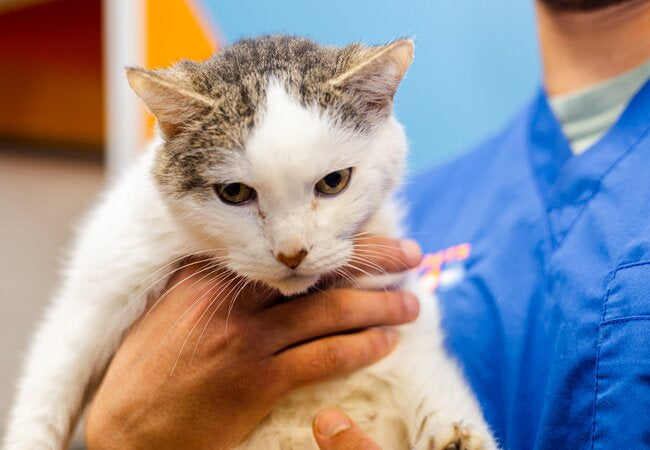Vet‑Approved 2025 Guide: Perineal Urethrostomy in Cats – Procedure, Recovery & Long-Term Care 🐱

In this article
Vet‑Approved 2025 Guide: Perineal Urethrostomy in Cats – Procedure, Recovery & Long-Term Care 🐱
By Dr. Duncan Houston BVSc
A perineal urethrostomy (PU or “PU surgery”) is a surgical procedure performed in male cats to create a larger, permanent urinary opening further back on the urethra. It’s recommended for cats with recurrent or unresolvable urethral obstructions—often due to crystals, stones, mucous plugs, inflammation, trauma, or tumors—that threaten their ability to urinate. In this detailed 2025 vet-approved guide by Dr. Duncan Houston BVSc, we cover why PU is needed, how it’s performed step-by-step, what to expect during recovery, possible complications, long-term care, cost, and how enrichment tools from Ask A Vet can support a smooth healing process. 🐱✨
🔍 Why PU Surgery Is Performed
Male cats have a long, narrow urethra prone to obstruction by:
- Feline lower urinary tract disease (FLUTD), with inflammatory plugs or crystals.
- Stones or tumors blocking urine flow.
- Urethral strictures from trauma or chronic inflammation.
Obstruction is life-threatening. PU is recommended when a cat is blocked two or more times or cannot be catheterized effectively. Female cats rarely need PU due to their wider urethras.
📞 Emergency Stabilization First
Blocked cats require:
- Immediate catheterization to relieve obstruction
- IV fluids to correct dehydration, electrolyte imbalances, hyperkalemia
- Pre-anesthesia bloodwork to assess overall health
Once stable, veterinarians may recommend PU to prevent recurrence.
🔧 Step‑by‑Step PU Surgery
Performed under general anesthesia (often with a sacrococcygeal epidural block), the surgery typically takes 1–2 hours.
- Preparation: Cat in perineal (sternal) or dorsal position, perineum clipped/shaved. A urinary catheter may remain in place during surgery.
- Initial incision: Elliptical cut around prepuce/scrotum; scrotum tissue removed if male.
- Dissection: Isolate and transect penile attachments to the pelvis using sharp/blunt dissection; sever muscles to mobilize urethra.
- Urethral stoma creation: Dorsal urethral mucosa incised to bulbourethral gland level; mucosa sutured to skin (mucocutaneous junction), creating a drainboard ≈1.5–2 cm long.
- Peningectomy: The Remaining penile tissue amputated distal to the new opening.
- Closure: Clean wound; purse-string around anus often placed to prevent fecal contamination; skin closed in layers.
- Optional catheter: May be left for 24–48 hours; prolonged use can raise stricture risk.
✅ Immediate Benefits
PU effectively reduces the risk of future blockages, assuming no persistent stones—in fact, outcomes are typically excellent. Most cats never re-block; quality of life improves significantly.
💰 Cost & Hospital Stay
- Typical cost: $1,500–4,500, depending on diagnostics, surgeon expertise, and hospital stay.
- Hospital stay: Usually 1–2 days; can extend if complications arise.
🏡 Postoperative Recovery & Care
Recovery period lasts ~2 weeks—key care steps include:
- ✔️ E‑collar or body suit to prevent licking; strict use for 10–21 days.
- ✔️ Confined, calm space with paper-based litter to avoid contamination.
- ✔️ Monitor for pain, redness, swelling, discharge—report any issues.
- ✔️ Bloody or frequent urination is normal for a few days; clean gently.
- ✔️ Restrict activity—no jumping or multi-cat play—until sutures dissolve (~10–14 days).
- ✔️ Follow-up urine cultures at 1, 3, 6, and 12 months to monitor UTIs.
⚠️ Potential Complications
Complications may include:
- Stricture: Seen in ~12%—usually due to tension or catheter use; may require surgical revision.
- UTIs: More common post-op (~23%); managed with antibiotics and hygiene.
- Wound issues: Urine leakage, dermatitis, dehiscence, bleeding.
- Other risks: Incontinence, fistula, perineal hernia—rare but serious.
🐾 Long-Term Outcomes
Most cats live normal, happy lives post-PU, with the elimination of life-threatening obstructions. UTIs and occasional crystals may occur—menagement continues with veterinary support and lifestyle adjustment.
🛠️ Owner Tips & Support Tools
- Ask A Vet: Remote post-op check-ins, symptom assessments, and follow-up planning without office visits.
📞 When to Contact the Vet
- Inability to urinate or persistent straining
- Severe lethargy, vomiting, poor appetite
- Redness, swelling, discharge, or strong odor at the stoma
- Recurring UTIs or bloody urine beyond a week
- Incontinence or leakage that begins some weeks after surgery
🏁 Final Thoughts
A perineal urethrostomy is a life-saving surgery that dramatically reduces the risk of fatal urinary obstructions in male cats. While there's an increased risk of UTIs and rare complications, outcomes are overwhelmingly positive when performed by skilled veterinarians and followed by diligent aftercare. By combining advanced care with remote support via Ask A Vet, calming aids from you can help your cat recover smoothly and thrive for years to come. 🐱❤️
For personalized support, post-op check-ins, or recovery guidance—visit Ask A Vet anytime. Your kitty’s health journey is just a click away. 🐾✨






